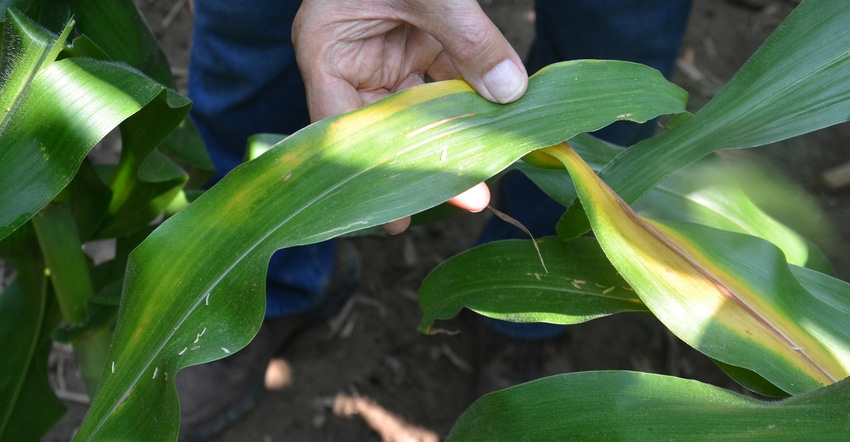
Crop scouts need sharp eyes this time of year. There may be more than one thing going on in a field at the same time. Dave Nanda proved that point when he visited the Corn Watch ’21 field recently.
“I was expecting to find disease lesions since there had been lots of moisture and humidity,” says Nanda, director of genetics for Seed Genetics Direct, the company sponsoring Corn Watch ’21. “I found some lesions, although not as many as I expected to find.
Related: How well did your corn pollinate?
“With disease, you need to continue scouting throughout the season, coming back fairly regularly. For a disease to take off and become serious, it needs a susceptible host, the disease organism and favorable environmental conditions.
“Since I found some gray leaf spot lesions on lower leaves, the inoculum was obviously there. That isn’t surprising since it overwinters here in crop residue. I don’t know how susceptible the hybrid is — that is something the seedsman and grower should discuss.
“Weather conditions appeared to be favorable since gray leaf spot likes humidity and warm weather. However, we should not assume anything. It could be that it wasn’t warm enough and humid enough at the same time. Nevertheless, when I find even a few lesions, it’s vital to keep scouting. With higher crop prices, if you’re going to pull the trigger and spray fungicide, you need to realize it can take time to line up someone to spray the corn.”
Nutrient deficiencies
Nanda found two plants side by side where there was a large gray leaf spot lesion on the lower leaf of one plant, and a different nutrient deficiency symptom showing on each plant (see picture). The leaf with the most obvious disease lesion also showed signs of sulfur deficiency (on left).
“There have been more reports of sulfur deficiency this year, especially earlier in the season,” Nanda says. “This leaf was showing the striping and yellowing up and down the outer edge of the leaf which is often associated with sulfur deficiency.
“Less sulfur is emitted into the atmosphere today by utility plants than 20 years ago. It’s not surprising that we might see symptoms of sulfur deficiency showing up in some areas.”
To see another picture of sulfur deficiency in corn and to learn more about the issue, grab a copy of the Purdue University Corn & Soybean Field Guide. The guide shows photos and describes symptoms for most nutrient deficiencies that you might encounter on corn or soybeans.
The other plant (on right) was showing classic symptoms of nitrogen deficiency on the leaf, Nanda says. Nitrogen deficiency first appears as yellowing at the tip of the leaf, and then progresses down the midrib. If the deficiency is severe enough, the leaf tissue will turn brown after being yellow, then become necrotic and die.
What should have been enough nitrogen was applied on this rotation field, Nanda says. However, large amounts of rain and uneven natural soil drainage in some parts of the field may have led to more nitrogen loss than normal, resulting in some leaves showing nitrogen deficiency symptoms.
About the Author(s)
You May Also Like




